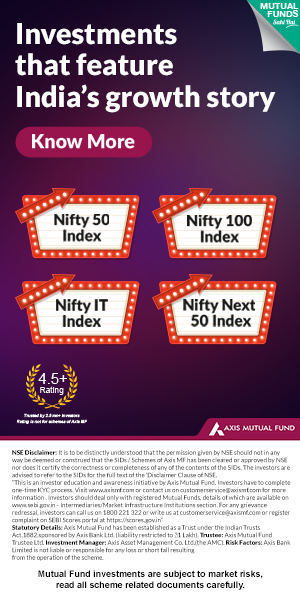Silver as an asset class

Silver like gold, is considered to be auspicious in India. Many Indian households buy silver on auspicious occasions like Akshay Tritiya, Dhanteras, and Diwali etc. In Indian cultural tradition silver jewellery and utensils are often gifted to new born babies or on auspicious events like Annaprashana. Apart from its use as jewellery or decorative purposes, silver also has industrial use especially in new age industries. Furthermore, like gold, silver is also considered to be a store of value or investment.
Why invest in silver?
- Silver, as an asset class, can be used in your asset allocation to diversify portfolio risks because silver has low correlation with equities (see the chart below).
![Asset allocation to diversify portfolio risks because silver has low correlation with equities Asset allocation to diversify portfolio risks because silver has low correlation with equities]()
Source: National Stock Exchange, goldprice.org, silverprice.org. Period as on 31st August 2022. Equity is represented by Nifty 50 TRI. Gold and silver returns are in INR. Disclaimer: Past performance may or may not be sustained in the future. The above chart is purely for investor education purposes and not for asset allocation recommendations. You should consult with your financial advisor before investing.
- Silver usually outperforms gold in bull-markets. Hence it can add further diversification to the asset allocation in your investment portfolio.
- Silver is also used in new age industries e.g. solar panels, electric vehicles, smartphones, advanced electronics etc. With the growth of these new age industries, silver demand for industrial use is expected to rise significantly in the future.
- Though industrial demand is rising, the supply of silver is relatively constrained. Therefore, there is considerable scope of higher returns on investment from silver.
How to invest in silver?
The traditional way of buying silver in India was in physical form i.e. silver jewellery, silver bars or biscuits and silver coins. The main problem with silver jewellery as an investment is impurity. Most silver jewelleries will have impurities. The impurities will be deducted from the price of silver when you are selling. The other problem with silver jewellery is maintenance; silver requires regular polishing to remove tarnishes. Finally, you need to incur storage costs (e.g. bank locker charges) for silver jewellery, bars and coins. Silver exchange traded funds (ETFs) and fund of fund (FOF) are much more cost efficient ways of investing in silver as there is no risk of impurities and no storage costs are involved.
Silver Exchange Traded Funds
Silver exchange traded funds (ETFs) are financial instruments which track the price of pure silver. These instruments invest in physical silver or silver related instruments. Physical Silver of 30 kg bars with fineness of 999 parts per thousand (or 99.9% purity) conforming to London Bullion Market Association (LBMA) Good Delivery Standards are only permitted by SEBI for silver ETFs. Further SEBI allows ETFs to invest in Exchange Traded Commodity Derivatives (ETCDs) with Silver as underlying asset. The exposure limits towards Silver ETCDs by the Silver ETFs may be capped at 10% of the Net Asset Value (NAV) taking into account the higher annualized rolling return over expenses in Silver ETCDs.You can see that investments in silver ETFs assures you of very high purity.
Silver ETFs are listed and traded in stock exchanges. You need to have Demat and trading accounts to invest in silver ETFs. During the ETF NFO period, you can invest in the ETF at par value. After the NFO period, you can buy or sell units of your silver ETFs in the stock exchange at market prices i.e. bid / offer prices. The bid / offer prices of ETF can be higher / lower than the NAV depending on the liquidity of the ETF. You can also buy or sell ETF units directly from / to the Asset Management Company (AMC) at applicable NAVs, if you are transacting (buying / selling) in lot sizes (creation units) as specified by the AMC. The lot sizes of ETFs are usually quite large.
Silver Fund of Fund
A silver fund of fund (FOF) is a mutual fund scheme which invests in silver ETFs. Silver FOF is like any open ended mutual fund scheme. You can buy or sell (redeem) silver FOFs from / to AMC at applicable NAVs either directly or through your mutual fund distributor. Furthermore, you invest in silver FOFs from your regular savings through Systematic Investment Plans (SIPs).
Should you invest in Silver ETF or FOF?
If you have demat and trading accounts you can invest in silver ETF. The total expense ratio (TER) of silver ETFs will be lower than silver FOFs; lower the TER, higher will be the return of the silver ETF or FOF. However, if you do not have Demat account or you are not comfortable buying / selling in stock exchange, you can invest in silver FOF. Silver FOFs offer all the conveniences of open ended mutual fund schemes.
Taxation of Silver ETFs and FOFs
Silver ETFs and FOFs are treated as non equity fund for taxation purposes. Capital gains from your silver ETF or FOF within 3 years from your investment date will be added to your income and taxed as per your income tax rate. Capital gains from your silver ETF or FOF after the completion of 3 years from your investment date will be taxed at 20% after allowing for indexation benefits. So your net tax rate after 3 years is likely to be lot less than 20%.
Conclusion
Though silver as a commodity has strong association with Indian culture and traditions, silver as a financial asset for purely investment purposes is relatively new in India. Though Gold ETFs were launched for the first time long back, Silver ETFs and FOFs have been launched only recently. As of end of August 2022, there are only 5 silver ETFs or FOFs but we expect more silver ETFs and FOFs to be launched in the future. In this article we have discussed the benefits of investing in silver ETFs and FOFs. You should consult with your mutual fund distributor if silver ETF or FOF is suitable for your asset allocation needs.
Mutual Fund Investments are subject to market risk, read all scheme related documents carefully.
Axis Mutual Fund launched its first scheme in October 2009 Since then Axis Mutual fund has grown strongly. We attribute our success thus far to our 3 founding principles - Long term wealth creation, Outside in (Customer) view and Long term relationship. Come join our growing family of investors and give shape to your desires.
Quick Links
Other Links
Follow Axis MF
POST A QUERY






